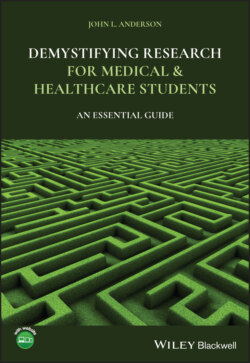Читать книгу Demystifying Research for Medical and Healthcare Students - John L. Anderson - Страница 32
The ‘Logic’ of the Experimental Approach
ОглавлениеHow often do we, and others, ask the question, ‘I wonder what happens if I … remove this thing here/do this instead of that/etc.’ Famous last words. How many of us, when we see a sign saying WET PAINT, instead of avoiding the painted surface, touch it to see if it is really wet?! (Some of us never really shed those childhood rebellious behaviours!) So we or they touch the paint, and end up with sticky fingers! ‘Yup. I guess it IS wet paint!’ is the conclusion!
This may sound like a banal example, but it illustrates the first level of experimentation. We begin with a hypothesis – ‘the paint is not wet’ – and we test our hypothesis – by touching the wood (or better still, by encouraging someone else to touch it) – using the tried and tested approach of ‘touch it and see’. This act of experimentation then either confirms our hypothesis – ‘Yes, the paint is wet! Now where do I clean my hands?!’ – or it refutes (denies) our hypothesis – ‘No, the paint is not wet. Phew!’
So, the process is simple:
We have a question – ‘Is that paint wet?’
We state our hypothesis – ‘My hunch is that the paint is not wet’ – this implies the nul hypothesis – ‘My hunch is that the paint is wet’.
We carry out our experimentation – we touch the paint.
We note the result – the paint is wet!
We conclude that this has refuted our hypothesis – it has confirmed the nul hypothesis – the paint is wet.
We disseminate our findings – ‘Look out – that paint really is wet!’
Easy! Now go on and think of a few examples on your own – if you send your ideas to me, I shall include the ones I like best and acknowledge you in the next edition of this book!
As an experiment, the hypothesis would have been ‘Touching the paint will not dirty my hand – the paint is dry’. And the nul hypothesis (the opposite of the hypothesis) would have been …? Yes, that's right, ‘Touching the paint will dirty my hand – the paint is not dry’. And the intervention would have been – touching the paint. The outcomes would have been:
1 my hand will remain clean – the paint was dry; or
2 my hand will be messy – the paint was not dry.
Now, some of you might argue that this is not a true experiment – the act of touching the paint was not a true intervention, it was an ‘interrogation’ or ‘questioning’ or ‘testing’ of the paint. I'm not going to argue – you could take it either way, but I hope it shows the point I am trying to make – experimentation is a part of our daily lives! We are born researchers and experimenters.
One more thing to note is that not all experimental approaches are truly hypothetico‐deductive, some are hypothetico‐inductive – we don't have a clue about what might happen when we press the button to set off the atom bomb, but we want to find out …
